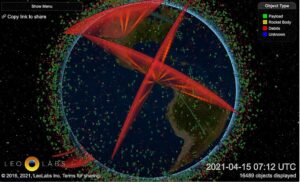“It’s the first radar in our network that tracks objects in low inclination orbits.”
LeoLabs operates six phased-array radars at four sites. The Silicon Valley firm operates one UHF radar in Texas and another in Alaska. In Costa Rica, like in New Zealand, LeoLabs operates two S-band radars on a single site to detect and track small space objects.
Having a second S-band radar site “is the key for us being able to track and maintain custody of objects smaller than 10 centimeters,” said Ed Lu, LeoLabs co-founder and vice president of strategic projects.
Since it was founded in 2015, LeoLabs has been mapping spacecraft and debris in low Earth orbit. The firm’s initial radars were designed to pinpoint objects as small as 10 centimeters. With the Kiwi Space Radar unveiled in 2019, LeoLabs began observing objects as small as 2 centimeters.
Pinpointing objects at a single point, however, makes it impossible to determine the orbit with high confidence. “When you get a second site, you get a minimal ability to do that,” said Lu, a physicist and former NASA astronaut.
LeoLabs plans to continue to establish radars around the world to provide additional observations, Ceperley said.
When LeoLabs began looking for an equatorial radar site, Lu contacted Franklin Chang-Diaz, another physicist and former NASA astronaut who is also a Costa Rican-American mechanical engineer.
Chang-Diaz agreed enthusiastically.
“I want to bring Costa Rica into the space age,” said Chang-Diaz, CEO of Ad Astra Rocket Co., a Texas-based firm with a subsidiary in Costa Rica. “Costa Rica has all the right ingredients. It’s a stable, educated society in a peaceful country.”
In addition, the LeoLabs project aligns well with “Costa Rica’s interest in environmental stewardship and projects that into space,” Chang-Diaz said. “The environment doesn’t end with our atmosphere. It’s going to extend far beyond that.”
LeoLabs provided all the funding for the Costa Rica Space Radar, which was constructed in less than a year with the support of the Costa Rican government.
Costa Rican officials “helped us make sure that we were able to meet all the local requirements and engage in a positive manner,” Ceperley said. “It’s critical that we develop positive relationships with the local government, with the national government and with the agencies because our intention is for that site to be powering space traffic management for the next 20 years.”
Both Lu and Chang-Diaz said orbital debris tracking and mitigation is vital to the economic development of space. In addition, the former astronauts are concerned about the threat untracked debris poses to people living and working on the International Space Station.
“The number one danger to astronauts aboard the International Space Station has been and is today the risk of orbital debris that is too small to be tracked by the U.S. Department of Defense going through the hull,” Lu said. “The biggest potential impediment to further economic development of space is orbital debris.”



